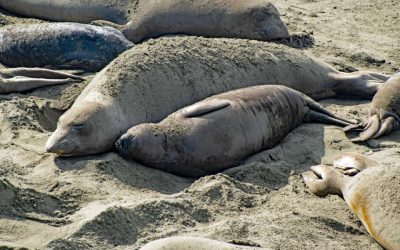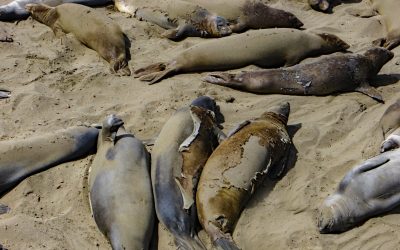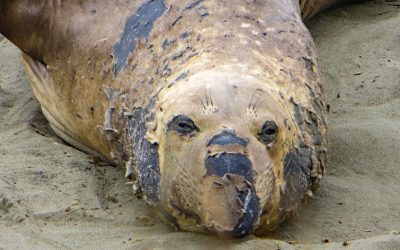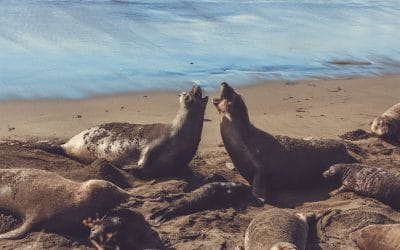
March
Adult males that arrived in December leave the beach. They have lost as much as 40% of their weight, after fasting for over three months. The older weanlings will begin to make their way to the near-shore waters. For those raised on the higher, distant parts of the beach, this will be their first contact with the ocean.
Swimming, holding their breath and developing their underwater vision, are all parts of “swim school” for these weanlings. At sea they will be finding food, both day and night, at depths that have little or no light. Because much of their swim practice occurs at night, we miss out on most of it. They develop their swim muscles and increase the oxygen carrying capacity of their blood and muscles. They gain abilities to control the circulation of blood while diving.
One by one, as they feel ready, they go to sea and begin a foraging trip that will bring them back to the rookery in the fall. Finding food is a skill they will develop as they travel.
January
This is the month with the most births. Mothers give birth a few days after arrival. While labor may be long, the actual birth usually takes only a few minutes. Mom immediately turns to bond with the new-born, sniffing, listening, and “talking” in a high-pitched...
February
Birthing peaks in January and continues into February. Mating peaks in mid-February. There may be fights as males try to improve their standing. As their mothers leave the beach to finally break their fast, the weaned pups gather in “pods” near the bluffs, avoiding...
April – May
Adult females that left the rookery after weaning their pups, as well as juveniles that were out at sea all winter, begin arriving late in March. This is the start of the molting season. Growing new skin at sea would cause a tremendous heat loss. Instead, they come...
June – September
In June we begin to see the arrival of males with the first sign of puberty – the growth of the nose (proboscis) which begins at about age five. As the molting season continues, we then see more older males, finishing with the arrival of the adult males in July and...
September – November
Before all the big males have left, the fall haul-out begins. Juveniles of both sexes return from their post-molt migration. They have been at sea since their molt in the spring. As youngsters, they come ashore in the fall, but as they grow into adults, they will make...
December
Adult male elephant seals weighing 3500 to 5000 pounds (1600 to 2300 kg) begin arriving late in November and will continue to arrive through much of December for the birthing and breeding season. Elephant seals birth and mate in harems. Only the strongest and most...
Stay Up to Date With The Latest News & Updates
DONATE
Sed ut perspiciatis unde omnis iste natus error sit voluptatem accusantium doloremque
Join Our Newsletter
Follow Us
Follow Friends of the Elephant Seals on our social channels for up-to-the-minute updates and images from the rookery.

Friends of the Elephant Seal is a cooperating association with California State Parks.







